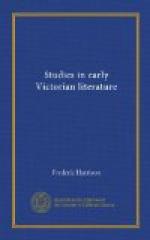But within this limited range of life, this uniformity of “genteel comedy,” Trollope has not seldom given us pieces of inimitable truthfulness and curious delicacy of observation. The dignitaries of the cathedral close, the sporting squires, the county magnates, the country doctors, and the rectory home, are drawn with a precision, a refinement, an absolute fidelity that only Jane Austen could compass. There is no caricature, no burlesque, nothing improbable or over-wrought. The bishop, the dean, the warden, the curate, the apothecary, the duke, the master of fox-hounds, the bishop’s wife, the archdeacon’s lady, the vicar’s daughter, the governess, the undergraduate—all are perfectly true to nature. So, too, are the men in the clubs in London, the chiefs, subordinates, and clerks in the public offices, the ministers and members of Parliament, the leaders, and rank and file of London “society.” They never utter a sentence which is not exactly what such men and women do utter; they do and they think nothing but what such men and women think and do in real life. Their habits, conversation, dress, and interests are photographically accurate, to the point of illusion. It is not high art—but it is art. The field is a narrow one; the actors are ordinary. But the skill, grace, and humour with which the scenes are caught, and the absolute illusion of truthfulness, redeem it from the commonplace.
The stage of Trollope’s drama is not a wide one, but it is far wider than that of Jane Austen. His plots and incidents are sufficiently trite and ordinary, but they are dramatic and original, if contrasted with those of Emma or Mansfield Park. No one will compare little Jane’s delicate palfrey with Anthony’s big-boned hunter; nor would any one commit the bad taste of treating these quadrupeds as if they were entered for a race; but a narrow stage and familiar incidents are not necessarily fatal to true art. If Trollope had done nothing more than paint ordinary English society with photographic accuracy of detail, it would not be a great performance. But he has done more than this. In the Barsetshire series, at any rate, he has risen to a point of drawing characters with a very subtle insight and delicate intuition. The warden, the bishop, Mrs. Proudie, Dr. Thorne, Mary Thorne, Lily Dale, Lady Arabella, and, above all, Mr. Crawley, are characters definitely conceived, profoundly mastered, and truly portrayed. Trollope evidently judged Crawley to be his greatest creation, and the Last Chronicle of Barset to be his principal achievement. In this he was doubtless right. There are real characters also in the two Phineas Finn tales. Chiltern, Finn, Glencora Palliser, Laura Kennedy, and Marie Goesler, are subtly conceived and truly worked out. This is enough to make a decent reputation, however flat be the interminable pot-boilers that precede and follow them.




